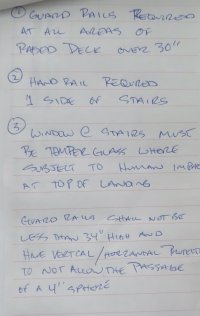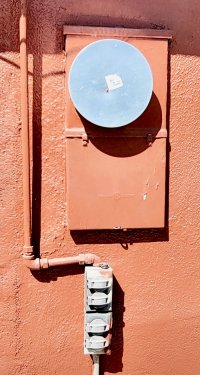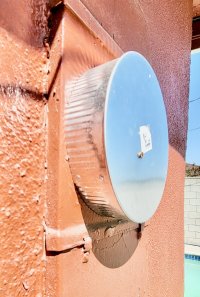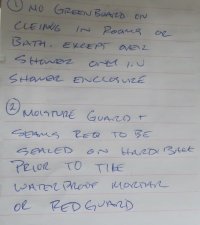-
Welcome to The Building Code Forum
Your premier resource for building code knowledge.
This forum remains free to the public thanks to the generous support of our Sawhorse Members and Corporate Sponsors. Their contributions help keep this community thriving and accessible.
Want enhanced access to expert discussions and exclusive features? Learn more about the benefits here.
Ready to upgrade? Log in and upgrade now.
You are using an out of date browser. It may not display this or other websites correctly.
You should upgrade or use an alternative browser.
You should upgrade or use an alternative browser.
An average day
- Thread starter ICE
- Start date
Your opinion is almost correctPolyethylene gas pipe, ABS sewer pipe and copper or CPVC or PVC or PEX water pipe can be in contact with each other. You can add electrical conduit to the list if it is separated from copper pipe. The tracer wire for polyethylene gas pipe need not be yellow but shall be a minimum #14 awg.
Well that's better than completely wrong. Had I specified metallic conduit it would have been nearly, entirely correct. But hey now as a moderator I have the ability to fix it ....so I will. So few people say anything that I wonder if anyone reads this stuff ...Welcome to the forum and thanks for pointing out the error.Your opinion is almost correct
I say "nearly, entirely correct" due to the omission of the requirement for a sleeve required for PEX that is buried in soil. It would then not be in contact with any of the other items....so in essence the PEX could have been left out altogether.
Polyethylene gas pipe, ABS sewer pipe and copper or CPVC or PVC or PEX water pipe can be in contact with each other. You can add electrical conduit to the list but if it is metallic conduit it shall be separated from copper pipe. The tracer wire for polyethylene gas pipe need not be yellow but shall be a minimum #14 awg.
Last edited:
Care to explain your comment? Knowledgeable retorts are always welcome.Your opinion is almost correct
I think I spotted the crux of the comment.....however, sijen110 is located in London so it's not a stretch to assume that sijen110 is British in which case my mistake might have been grammatical in nature.Care to explain your comment? Knowledgeable retorts are always welcome.
The man in the photo is Hao Tung. It was a kick to talk with him due to a thick British accent. He lives in England where he was raised from toddlerhood. His wife Sardina is also Chinese. She was raised in France and has a thick French accent. Neither of them speak Chinese. My wife speaks Chinese. When dining in restaurants we got some odd looks from other patrons. Kinda threw off the waitresses too!
Hao came to the USA to build a house for his sister. He did most of the work with a crew that he hired. The quality was top notch. Much of it, including all of the windows came in a container from Europe.
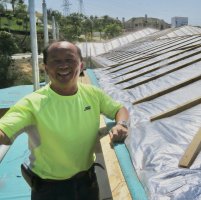
Hao got in a beef with the plan check engineer and built the cantilevered concrete deck without a permit.
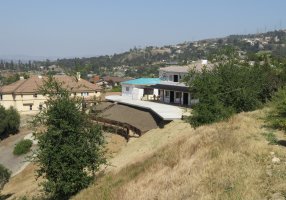
Last edited:
The job is a residential service panel upgrade done by a licensed electrical contractor.
There had been a large LB on the side of the enclosure. The door was notched to clear the LB. The LB served no purpose and an inspection wrote a correction to remove the LB and fill the missing KO. The contractor removed the LB and welded a patch. The door also has a welded patch to repair the notch. I didn't get a picture of the outside weld but I was told that it looks a little better than the inside weld. It has been painted and the paint is flaking off.
A different inspector has been sent there for a final inspection. That inspector asked for my opinion.
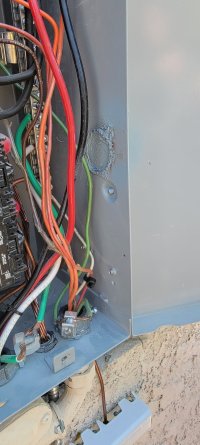
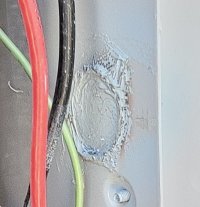
There had been a large LB on the side of the enclosure. The door was notched to clear the LB. The LB served no purpose and an inspection wrote a correction to remove the LB and fill the missing KO. The contractor removed the LB and welded a patch. The door also has a welded patch to repair the notch. I didn't get a picture of the outside weld but I was told that it looks a little better than the inside weld. It has been painted and the paint is flaking off.
A different inspector has been sent there for a final inspection. That inspector asked for my opinion.


Looks like the licensed electrical contractor did what he was instructed to do! Your advise was, to move on?The LB served no purpose and an inspection wrote a correction to remove the LB and fill the missing KO.
Does the CBC or adopted electrical code in CA require the grounding wire (GEC) to be protected in conduit? Is that just a phone tap or is the phone tap on your GEC?
The panel enclosure arrived with an LB attached which indicates that the enclosure is not new. The door had to be modified to clear the LB which indicates that a hole was punched in the side of the enclosure, The weld is amateurish at best and the paint is already failing. In the not too distant future the side of the enclosure will be rusted.Looks like the licensed electrical contractor did what he was instructed to do! Your advise was, to move on?
Does the CBC or adopted electrical code in CA require the grounding wire (GEC) to be protected in conduit? Is that just a phone tap or is the phone tap on your GEC?
I advised the inspector to turn it down based on 110.3(B) and 110.12. I also told him that if the contractor complains to management the correction will most likely be overturned. The reasoning will be that the intent of the code has been met and any future defect will be the result of improper maintenance.
One of the criteria that I will apply is what would I accept were I the customer. Now I know that is not okay by the strict application of code or even the job description. Consider it to be a thumb on the scales of justice. I don't do that every time....just like I don't turn down holes punched in enclosures every time....sometimes I add it all up and just a small nudge pushes it off the cliff.
The code does not require all GEC to be protected with conduit....it depends on the size of the wire and if there is the potential for physical damage. The #4 stranded in the picture is the GEC and there is a missing bonding bushing and most likely a a cable clamp was used to secure the flex to the cabinet. To the right of that is an inter-system bonding terminal.
Mech
REGISTERED
Is that a chimney cap to contain any smoke in the enclosure? Is a separate mechanical permit required for that?
steveray
SAWHORSE
It's for when they let all of the smoke out of the wires.....Is that a chimney cap to contain any smoke in the enclosure? Is a separate mechanical permit required for that?
Not sure about CBC but See IRC R104.11. Maybe allowed? Alternative materials, designs and methods
May not be the Building Officals call?
May be the POCO's call?
IRC R104.11.1 Tests, if BO's call could request a test
Mark would you allow this?
May not be the Building Officals call?
May be the POCO's call?
IRC R104.11.1 Tests, if BO's call could request a test
Mark would you allow this?
NoNot sure about CBC but See IRC R104.11. Maybe allowed? Alternative materials, designs and methods
May not be the Building Officals call?
May be the POCO's call?
IRC R104.11.1 Tests, if BO's call could request a test
312.2 says that in damp or wet locations cabinets, cutout boxes, and meter socket enclosures shall be placed and equipped to prevent moisture or water from entering and accumulating within the cabinet, with no mention of a requirement that the product be listed.
However, any equipment you use (listed or not) has to be approved by the inspector to be legal (110.2), and I bet that thing is listed for something, but probably not listed for weatherproofing electrical equipment, so it wouldn't comply with 110.3(B) because it isn't installed in a way that meets the manufacturer's instructions. It's really up to the inspector - which in this case is ICE - so he has very firm footing to reject this installation.
Listing and labeling is intended to be a guide to help inspectors be more comfortable with the products they are approving under 110.2. Therefore, if a product is required to be listed under the code, it needs to be listed and comply with 110.3(B). In my opinion, if a product is used in a way it wasn't intended to be used, and what they are using it for isn't required to be listed, but the product is listed for something else, as in this case, it is up to the inspector to decide if they will approve the installation.
I would tell the electrician to effectively bond that cover somehow, caulk the cover to the enclosure to waterproof it, replace the screw with a roofing screw with a neoprene washer to waterproof the screw hole, and call it good. If they don't want to do that, they can install something intended for the purpose. Odds are very good they will buy a product intended for that use, but if they don't I would still be able to approve the installation.
I like to give people choices...
However, any equipment you use (listed or not) has to be approved by the inspector to be legal (110.2), and I bet that thing is listed for something, but probably not listed for weatherproofing electrical equipment, so it wouldn't comply with 110.3(B) because it isn't installed in a way that meets the manufacturer's instructions. It's really up to the inspector - which in this case is ICE - so he has very firm footing to reject this installation.
Listing and labeling is intended to be a guide to help inspectors be more comfortable with the products they are approving under 110.2. Therefore, if a product is required to be listed under the code, it needs to be listed and comply with 110.3(B). In my opinion, if a product is used in a way it wasn't intended to be used, and what they are using it for isn't required to be listed, but the product is listed for something else, as in this case, it is up to the inspector to decide if they will approve the installation.
I would tell the electrician to effectively bond that cover somehow, caulk the cover to the enclosure to waterproof it, replace the screw with a roofing screw with a neoprene washer to waterproof the screw hole, and call it good. If they don't want to do that, they can install something intended for the purpose. Odds are very good they will buy a product intended for that use, but if they don't I would still be able to approve the installation.
I like to give people choices...
Plastic is not a permanent solution as sunlight destroys plastic. Caulk is not recommended. Metal meter socket covers are available. The thing about meter socket covers is that they are considered to be temporary. I have seen many panel enclosures that were converted to junction boxes and sub-panels. I have approved many with meter socket covers. I probably should have turned them down due to a lack of confidence that they are watertight.
The pictures of the duct cap were sent to me by an inspector....I can't say "another inspector" anymore because I am not an inspector anymore.
The pictures of the duct cap were sent to me by an inspector....I can't say "another inspector" anymore because I am not an inspector anymore.
That is sad.Ice..............not an inspector anymore? what?
For several reasons I have retired from LA County. I have a few projects to get done around the house and then I might go back to work somewhere else as a contract inspector.....or I might enjoy not putting up with the BS.Ice..............not an inspector anymore? what?
Last edited:

